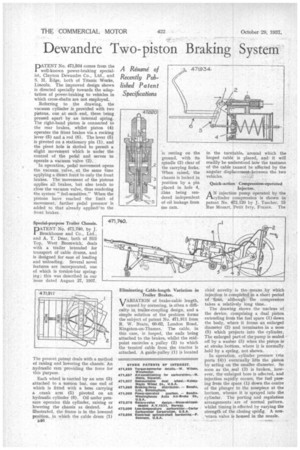Dewandre Two-piston Braking System
Page 148

If you've noticed an error in this article please click here to report it so we can fix it.
PATENT No. 471,934 comes from the well-known power-braking specialist, Clayton Dewandre Co., Ltd., and S. H. Edge, both of Titanic Works, Lincoln. The improved design shown is directed specially towards the adaptation of power-braking to vehicles in which cross-shafts are not employed.
Referring to the drawing, the vacuum cylinder is provided with two pistons, one at each end, these being pressed apart by an internal spring. The right-hand piston is connected to the rear brakes, whilst piston (4) operates the front brakes via a rocking lever (5) and a rod (6). The lever (5) is pivoted on a stationary pin (1), and the pivot hole is slotted to permit a slight movement which is under the control of the pedal and serves to operate a vacuum valve (2).
In operation, pedal movement opens the vacuum valve, at the same time applying a direct force to only the front brakes. The movement of the pistons applies all brakes, but also tends to dose the vacuum valve, thus rendering the system " feel-sensitive." When the pistons have reached the limit of movement, further pedal pressure is added to that already applied ' to the front brakes.
Special-purpose Trailer Chassis.
DATENT No. 471,740, by J.
Brockhouse and Co., Ltd., and A. T. Dear, both of Hill Top, West Bromwich, deals with a trailer intended for transport of cable drums, and is designed for ease of loading and unloading. Several novel features are incorporated, one of which is torsion-bar springing; this was described in our issue dated August 27, 1937.
The present patent deals with a method of raising and Towering the chassis. An hydraulic ram providing the force for this purpose.
Each wheel is carried by an arm (3) attached to a torsion bar, one end of which is fitted with a boss carrying a crank arm (5) pivoted on an hydraulic cylinder (6). Oil under pressure operates this cylinder, raising or lowering the chassis as desired. As illustrated, the frame is in the lowered position, in which the cable drum (1) 1346 is resting on the ground, with its spindle (2) clear of the carrying forks. When raised, the chassis is locked in position by a pin placed in hole 4, .thus being rendered independent of oil leakage from toe ram.
Eliminating Cable-length Variation in Trailer Brakes.
VARIATION of brake-cable length, V caused by cornering, is often a difficulty in trailer-coupling design, and a simple solution of the problem forms the subject of patent No. 471,911 from R. W. Neate, 60-62, London Road, Kingston-on-Thames, The cable, in this case, is looped, the ends being attached to the brakes, whilst the midpoint encircles a pulley (2) to which the tensioii cable from the tractor is attached. A guide-pulley (1) is located
OTHER PATENTS OF INTEREST. 471,889 Torque.converter details.--W. Wilson, Winchester.
471,897 Air-conditioning tor carburetters.-.11, Noble, Norwich.
471,957 Demountable dual wheel.—KelSey• Hayes Whool Co„ U.S.A.
471,939 Braking.torCe distributor. — Bendix, Ltd„ Birmingham.
471,999 Power-operated gearbox. — Bench* Westinghouse Auto Air-Brake CO., U.S.A.
472,070 Rotary-valve dosign.—Motoraktieselsitopet A.V.1935, Norway, 472,090 Low-temperature carburetter—Carter Carburetter CorPoration, U.S.A. 472,099 Electrical splined.shatt hardening.---F. Denneen. U.S.A.
in the turntable, around which the looped cable is placed, and it will readily be understood how the tautness of the cable cannot be affected by the angular displacement .between the two vehicles. : Quick-action Compression-operated Injector.
AN injection pump operated by the cylinder compression is shown in patent No, 472,120 by J. Tuscher, 15 Rue Mozart, Petit Ivry, France. The
chief novelty is the means by which injection is completed in a short period of time, although the compression takes a relatively long time,
The drawing shows the nucleus of the device, comprising a dual piston extending from the fuel space (1) down the body, where it forms an enlarged diameter (2) and terminates in a nose (5) which projects into the cylinder. The enlarged part of the pump is sealed • off by a washer (3) when the piston is at stroke bottom, where it is normally, held by a spring, not shown.
In operation, cylinder pressure (via ports (4)) eventually lifts the piston by acting on the smaller diameter. So soon as the seal (3) is broken, however, the enlarged bore is affected, and injection rapidly occurs, the fuel passing from the space (1) down the centre of the plunger to the nosepiece at the bottom, whence it is sprayed into the cylinder. The porting and regulation arrangements are of normal pattern, whilst timing is effected by varying the strength of the closing sprig. A non-eturn valve is housed in the nozzle.
























































































































































































